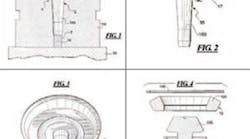We tend to think of technological advancements happening in industries that are comparatively young. Computer technology most of us believe to have been around more or less in its current form since the 1940s. That makes computers a relatively young industry, at least by comparison to forging, which by most accounts has been in development for 6,500 years. This sort of time disparity may lead some to believe mankind has just about exhausted the extent to which we can improve upon smashing a chunk of metal with a hammer, but they’d be wrong.
In the little hamlet of Meadville, PA, with the population of just under 14,000 souls, a new technology for simultaneously forging two parts was assigned at the beginning of March to Meadville Forging Co. It is the work of lone inventor Carl McLean from the even smaller town of Conneaut Lake, PA, population just over 700. While university and corporate researchers in the world’s metropolises race to build faster super computers and uncover the latest subatomic particles, it is the remote inventor in the smallest of towns that carries on the quest for ever more efficient ways to forge components for the machines that make the world work.
In previous iterations of forging technologies to strike multiple components in a single die the cavities were separate. They also required separate billets placed in each cavity. The Meadville patent calls for a different arrangement wherein the cavities are concentric and a single billet is placed in the innermost cavity. Admittedly, the inner and outer cavities are connected by a “connecting opening” to allow material to flow from the innermost cavity to the outermost cavity.
It seems clear from the patent that while this technique is not restricted to a certain type of application, it was designed with a specific application in mind as the optimal use of the technology. Namely, this arrangement is perfectly suited for producing a pinion-gear blank and its associated ring gear blank in a single strike. In the strike, material fills the inner cavity and then passes through the connecting opening and fills the outer cavity. Finally, the excess material flows out to the opening at the outer edge of the cavity. Given the design of the pinion gear blank’s depth, the inner die cavity is fitted with an ejector pin in the bottom of the cavity to dislodge the part after striking.
Once formed, the two components are separated in a single trimming/piercing operation. In a very real sense, the material forming the connection between the two components that has flowed through the connecting opening is just flash. So again, it appears that what would have been two operations to trim the flash on each component is now combined into one operation for both. The net effect is less handling, less machinery, and lower costs. Thought of the other way around, throughput can be essentially doubled with the same investment in time and equipment.
There is a tenet in science called Occam’s razor: that the simplest solution to a problem is most likely the correct one. McLean’s patent may not seem as sexy as computer science or particle physics, but it is brilliant, and elegant in its simplicity; an “ah-ha” moment in an industry six and a half millennia in development. In an age where ephemeralization forces us to struggle for even the most miniscule efficiencies to maintain our competitive edge, a doubling in efficiency is nothing short of miraculous.
Paul DQ Campbell is an author, and freelance technology writer. For more info or to contact Paul, visit www.pdqcampbell.com










